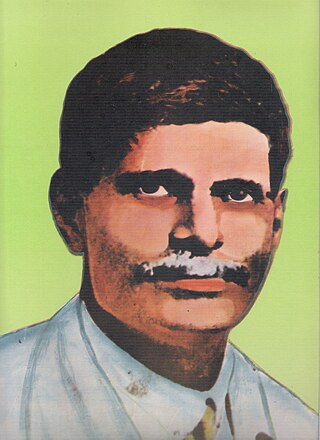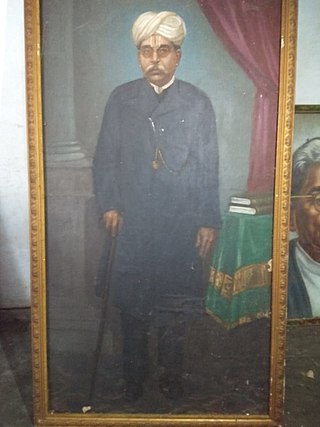Naidu is a title used by some South Indian Telugu communities. 'Nayudu/Naidu' (నాయుడు) is a contraction of the Telugu word 'Nayakudu' (నాయకుడు) meaning leader, chief, headman. Telugu castes such as the Balija,Kapu/Telaga, Kamma, Gavara, Golla, Turpu Kapu, Velama and Boya use the title.

Coastal Andhra or Kostandhra is a geographic region in the Indian state of Andhra Pradesh. Vijayawada is the largest city in this region. Region share borders with Uttarandhra, Rayalaseema and Telangana. It was part of Madras State before 1953 and Andhra State from 1953 to 1956. According to the 2011 census, it has an area of 91,915 square kilometres (35,489 sq mi) which is 57.99% of the total state area and a population of 34,193,868 which is 69.20% of Andhra Pradesh state population. This area includes the coastal districts of Andhra Pradesh on the Circar Coast between the Eastern Ghats and the Bay of Bengal, from the northern border with Odisha to Rayalaseema in the south.

Rajahmundry, officially known as Rajamahendravaram, is a city in the Indian state of Andhra Pradesh and district headquarters of East Godavari district. It is the fifth most populated city in the state. During British rule, the district of Rajahmundry was created in the Madras Presidency in 1823. It was reorganised in 1859 and bifurcated into the Godavari and Krishna districts. Rajahmundry was the headquarters of Godavari district, which was further bifurcated into East Godavari and West Godavari districts in 1925. When the Godavari district was bifurcated, Kakinada became the headquarters of East Godavari and Eluru the headquarters of West Godavari. It is administered under Rajahmundry revenue division of the East Godavari district. The city is known for its floriculture, history, culture, agriculture, economy, tourism, and its heritage. It is known as the "Cultural Capital of Andhra Pradesh".

Kandukuri Veeresalingam was a social reformer and writer from the Madras Presidency, British India. He is considered as the father of the Telugu Renaissance movement. He was one of the early social reformers who encouraged the education of women and the remarriage of widows. He also fought against child marriage and the dowry system. He started a school in Dowlaiswaram in 1874, constructed the 'Brahmo Mandir' in 1887 and built the 'Hithakarini School' in 1908 in Andhra Pradesh. His novel Rajasekhara Charitramu is considered to be the first novel in Telugu literature.
Kapu is a Hindu caste mainly found in the Indian state of Andhra Pradesh. They are classified as a Forward caste. They are a community of land-owning agriculturists. Historically, they have also been warriors and military generals (Nayakas) in Hindu armies. They are a dominant caste of Andhra Pradesh. Kapus commonly carry the title Naidu. They are primarily present in Coastal Andhra with major concentration in the Godavari-Krishna delta region.

Rao Bahadur Sir Kurma Venkatareddi NaiduKCSI was an Indian politician, lawyer, diplomat, and professor who served as the Prime Minister of Madras Presidency. He also served as the Governor of Madras Presidency — one of the only two Indians in history to have held the post. He was the only person to have held both the posts of Prime Minister and Governor of the Madras Presidency. As a prominent leader of the Justice Party, he formulated policies that promoted social equality, abolition of untouchability, and social reform. He also established the first women's college in Andhra region in Eluru.
Telaga is a community found in Coastal Andhra region of India. Telaga is a subcaste of Kapu and both terms are often used synonymously. They are classified as a Forward caste. They are a land-owning agrarian community. Historically, they were a warrior caste known for their honour and bravery.

Kasinadhuni Nageswararao, better known as Nageswara Rao Pantulu, was an Indian journalist, nationalist, politician, businessman, and a staunch supporter of Khaddar movement. He participated in the Indian independence movement and in the Indian National Congress party, including Mahatma Gandhi’s civil disobedience movement through salt satyagraha. He was conferred with the title Desabandhu by the people of Andhra Pradesh. He was a major financier of Congress activities in Andhra and Chennai and is also known for patenting Amrutanjan. He was conferred with the title Desoddhaaraka by the Andhra Mahasabha. In 1935, the Andhra University honoured him with Kalaprapoorna, an honorary doctorate of Literature.

Raghupathi Venkaiah Naidu, was an Indian filmmaker, photographer, graphic artist, educationist and entrepreneur considered as the father of Telugu cinema. Regarded as one of the pioneers of Indian cinema, Naidu started his career as a commercial photographer in Madras; he was drawn into independent filmmaking, and he traveled to different regions in South east Asia to promote and teach cinematic techniques, filmmaking, and distribute foreign language silent films.

The Tank Bund Road is a road in Secunderabad, Hyderabad, India. The Tank Bund dams Hussain Sagar lake on the eastern side and connects the twin cities of Hyderabad and Secunderabad. It has become an attraction with 33 statues of famous people from the region.

Rao Venkata Kumara Mahipati Surya Rau CBE (1885–1964) was Maharajah of Pithapuram. He was called by Telugu people "Abhinava Krishnadevaraya". Maharani Sita Devi of Baroda was his daughter.
International Telugu Institute was established by the Government of Andhra Pradesh in 1975 in acceptance of a resolution unanimously adopted by the delegates to the first World Telugu Conference held at Hyderabad. It was later merged with the Potti Sreeramulu Telugu University in 1985 and renamed as the International Telugu Centre.
Venkata Ratnam or Venkataratnam is a given name. Notable people with the given name include:

Dewan Bahadur or Diwan Bahadur was a title of honour awarded during British rule in India. It was awarded to individuals who had performed faithful service or acts of public welfare to the nation. From 1911 the title was accompanied by a special Title Badge. Dewan literally means Prime Minister in Indian context and Bahadur means brave.

Digavalli Venkata Siva Rao, or Digavalli Śivarāvu, was a lawyer, historian and Telugu writer from Vijayawada, Andhra Pradesh. He is the author of forty-two books and some 300 articles written between 1924 and 1987. Some of his works are available in the Indian Digital Library.

Raja Kanchumarthi Ramachandra Rao was a zamindar of Dharmavaram. He is notable for the development of Rajahmundry. He was the son of Kanchumarthi Narasayya Naidu.
Kolachalam Venkata Rao was a freedom fighter and social reformer of Madras Presidency. He represented the state of Karnataka in the first session of the Indian National Congress. He was one of the early social reformers who encouraged widow remarriages and female education. He was the elder brother of Kolachalam Srinivasa Rao.
S. Muddu Narasimham Naidu (1792–1856) was an Indian writer and social reformer considered to be the first essayist in Telugu. He was a pioneer of the popular language movement, the widow remarriage movement and the rationalist movement in Andhra through his writings. He was a government officer by profession and served as a District Munsif in Rajahmundry.
Sri Suryaraya Andhra Nighantuvu is a Telugu language dictionary. It is the most comprehensive monolingual Telugu dictionary. It was published in eight volumes between 1936 and 1974. It was named after Rao Venkata Kumara Mahipati Surya Rau, the zamindar of Pitapuram Estate who sponsored the first four volumes of the dictionary.










